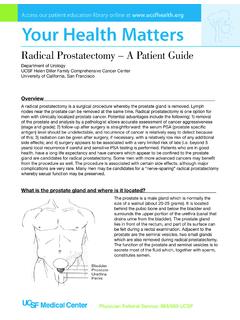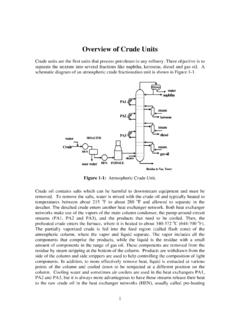Transcription of our eath atters - UCSF Department of Urology
1 Find a Doctor: (888) 689-8273 | Patient Education Library: Health MattersSDURO0110 Revised 07/21 radiation Therapy for Prostate Cancer A Patient Guide Urologic Oncology Program UCSF Helen Diller Family Comprehensive Cancer Center University of California, San Francisco - Tel: (415) 353-7171 This guide is designed to provide general information that may be helpful to you before starting and during radiation therapy. We hope this helps you understand what to expect from, and how to deal with, all aspects of being treated with radiation therapy. Special thanks to all previous contributors to this document. Definitions for words in bold can be found at the end of this document.
2 If you have non-urgent questions related to your health and treatment, please contact your healthcare provider through the UCSF online patient portal MyChart. If you think you may be experiencing a medical emergency, please call 911 or go to your closest emergency room. The MyChart portal can be accessed at: Your Feedback We regularly revise the information presented in this guide to keep it up to date and ensure it is as useful as possible to the reader. Because changes and new developments can occur frequently, we suggest that you talk to your health care provider for the latest information. Your feedback about any aspect of this guide is much appreciated. You can e-mail your comments to or send them by regular mail to Your Health Matters Box 1695, UCSF Department of Urology , San Francisco, CA 94143-1695.
3 If you wish to talk with a patient advocate, please call (415) 885-7210. This guide, along with other urologic oncology documents, can be viewed online with this link: If you are reading a hard copy, please also refer to the above link for the most up-to-date information. Authors Anthony Wong, MD, PhD; Osama Mohamad, MD, PhD; Departments of radiation Oncology and Urology , and UCSF Advocate Nathan Roundy2 Table of ContentsOverview ..3 What is the prostate gland, and where is it located? ..3 What is radiation Therapy? ..3 Why Would I Choose radiation Therapy? ..4 How is radiation Therapy Delivered? ..4 External Beam radiation Therapy Technological Advancement ..4 External Beam radiation Therapy fractionation .
4 5 Brachytherapy ..6 Testosterone Reducing Hormone Therapy (HT) ..7 What happens before and during external beam radiation therapy? ..7 radiation Treatment Plan ..8 How should I expect to feel during radiation therapy? ..8 How should I expect to feel after radiation therapy? ..9 Sexual function ..10 Sperm production ..10 Testosterone production ..10 What else do I need to know? ..11 Troubleshooting ..11 Follow-up: How often will I need to see my healthcare provider? ..12 How will I know if the treatment is working? ..12 Relationship Between Blood Level Testosterone and PSA Level After radiation + ADT ..12 Will I need additional treatment? ..13 Risk of Secondary Malignancy.
5 13 GLOSSARY ..14 For additional information about radiation therapy, please go to the following web site: ..173 OverviewRadiation therapy (RT) is an effective treatment for prostate cancer. This guide is a brief introduction to radiation therapy and an explanation of how it is used to treat prostate cancer. It is not meant to be all-inclusive but rather to provide enough information to empower you to have an informed discussion with your healthcare providers. As you read through radiation Therapy for Prostate Cancer A Patient s Guide, you will find words and terms in bold defined in the GLOSSARY at the end of this is the prostate gland, and where is it located?The prostate gland is typically about the size of a walnut and is located in front of the rectum and below the bladder.
6 The urethra, a hollow tube for draining urine from the bladder, exits the bottom of the bladder, passes through a urine control valve, through the middle of the prostate, out another urine control valve, and exits through the a part of the male reproductive system, cells in the prostate secrete fluid that makes up part of the semen. Semen is the milky fluid that nourishes, carries, and protects the sperm that are produced in the testicles. The prostate forcefully ejects semen into the urethra during ejaculation. The two urine control valves are also part of the ejaculation process to prevent urine leakage during is prostate cancer?Like most cells in the body, prostate cells are continuously, slowly being replaced.
7 Cancer happens when something goes wrong with the replacement process. Mutations in the cell division process cause the mutated cell to grow and divide when it should not, and/or to not die when it should. The mutations are passed on to the daughter cells and a growing mass called a tumor may result. Prostate cancer can behave very differently from one patient to the next. Most patients at diagnosis have a slow growing tumor that takes years to spread beyond the prostate and become a threat to their life. Active surveillance or observation is appropriate for these patients, as many will never need treatment. Others have rapidly growing tumors that may quickly access lymphatic channels or the bloodstream.
8 Sometimes these circulating tumor cells will lodge in another organ, such as a lymph node or a bone, and start a new colony of tumor cells called a metastasis. Widespread metastatic disease may lead to life-threatening complications or is radiation Therapy? radiation therapy uses ionizing radiation in the form of photons or protons to kill cancer cells by damaging their DNA. Cancer cells with damaged DNA cannot divide or multiply and will eventually die. The overarching goal of radiation therapy is to deliver a therapeutic dose of ionizing radiation to the tumor while minimizing the dose to surrounding healthy normal tissues. There are many methods for achieving this goal, as detailed 1: Male Anatomy4 Why Would I Choose radiation Therapy?
9 radiation therapy (RT) is an important resource for treating prostate cancer in many different clinical settings. For patients with localized (tumor confined to the prostate and seminal vesicles) or regionally advanced (tumor spread to adjacent pelvic lymph nodes only) prostate cancer, RT may be used with curative intent, and provides outcomes comparable to surgery. For those who undergo radical prostatectomy and have high risk prostate cancer features, RT may be used as an adjuvant or salvage therapy to improve cure rates compared to surgery alone. For those with metastatic disease, RT may be used to delay disease progression or palliate symptoms caused by tumors. The rationale, risks, and benefits of RT will depend on the clinical setting and the radiation technique employed.
10 You should discuss all treatment options with your healthcare providers. For additional information on possible alternative therapies at UCSF see Localized Prostate Cancer and its Treatment and Radical Prostatectomy Basic Information at How is radiation Therapy Delivered? There are two broad categories of radiation therapy: teletherapy ( healing from a distance ) and brachytherapy ( healing from close by ). Teletherapy is commonly referred to as external beam radiation therapy (EBRT) and involves an external source of radiation that beams photons (x-rays or gamma rays) or particles (protons or heavy ions) from outside the body into the tumor. The most common external radiation source in the modern era of radiation oncology is a megavoltage linear accelerator (LINAC) equipped with devices that allow precise shaping of x-ray photons and accurate tumor targeting.













